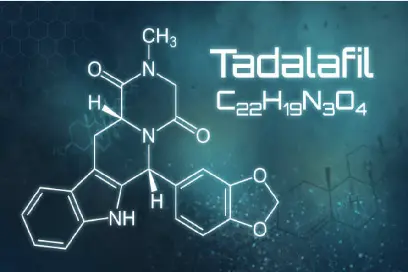Tadalafil raw powder represents one of the most significant pharmaceutical breakthroughs in treating erectile dysfunction and pulmonary arterial hypertension. Understanding the mechanism by which tadalafil raw powder inhibits phosphodiesterase type 5 (PDE5) is crucial for pharmaceutical professionals, researchers, and healthcare providers. This comprehensive analysis explores the molecular interactions, binding mechanisms, and biochemical pathways involved in PDE5 inhibition. The unique properties of tadalafil raw powder, including its selectivity and duration of action, make it a valuable active pharmaceutical ingredient (API) in modern medicine. By examining the structural characteristics and enzymatic interactions, we can better appreciate how this compound achieves its therapeutic effects through precise molecular targeting.

What Makes Tadalafil Raw Powder Selective for PDE5 Enzyme?
Molecular Structure and Binding Affinity
Tadalafil raw powder exhibits exceptional selectivity for PDE5 through its unique molecular structure, which features a distinctive carboline framework that specifically targets the enzyme's active site. The compound's three-dimensional configuration allows it to fit precisely into the PDE5 binding pocket, creating strong intermolecular interactions through hydrogen bonding and hydrophobic contacts. This structural complementarity is what gives tadalafil raw powder its remarkable specificity compared to other phosphodiesterase inhibitors. The methylenedioxyphenyl group and the carboline ring system work together to create a lock-and-key mechanism that prevents non-specific binding to other phosphodiesterase enzymes. Research has demonstrated that tadalafil raw powder shows over 10,000-fold selectivity for PDE5 compared to other PDE enzymes, making it highly effective while minimizing off-target effects. This selectivity is maintained even at therapeutic concentrations, ensuring consistent and predictable inhibition of the target enzyme.

Conformational Changes Upon Binding
When tadalafil raw powder binds to PDE5, it induces specific conformational changes in the enzyme structure that stabilize the inhibited state. The binding process involves multiple steps, beginning with the initial recognition and approach of the tadalafil molecule to the enzyme's active site. Upon contact, tadalafil raw powder causes a conformational shift in the enzyme's catalytic domain, effectively blocking access to the substrate binding site. This induced-fit mechanism ensures that the enzyme remains in an inactive state for an extended period, contributing to the long duration of action associated with tadalafil. The conformational changes also involve alterations in the enzyme's regulatory domains, which further enhance the stability of the inhibited complex. These structural modifications are reversible, allowing normal enzyme function to resume once tadalafil raw powder concentrations decrease through metabolic processes.
Competitive Inhibition Mechanism
Tadalafil raw powder functions as a competitive inhibitor of PDE5, meaning it competes directly with the natural substrate cyclic guanosine monophosphate (cGMP) for binding to the enzyme's active site. The inhibition constant (Ki) of tadalafil raw powder for PDE5 is remarkably low, indicating high binding affinity and effective competition with cGMP. This competitive nature means that the degree of inhibition depends on the relative concentrations of tadalafil raw powder and cGMP in the cellular environment. At therapeutic concentrations, tadalafil raw powder effectively outcompetes cGMP for binding sites, resulting in sustained elevation of cGMP levels. The competitive inhibition is characterized by its reversible nature, allowing for precise control of enzyme activity based on drug concentration. This mechanism ensures that PDE5 activity can be modulated in a dose-dependent manner, providing therapeutic flexibility and predictable pharmacological responses.
How Long Does Tadalafil Raw Powder Remain Active in the System?
Pharmacokinetic Properties and Half-Life
Tadalafil raw powder demonstrates exceptional pharmacokinetic properties that contribute to its extended duration of action, with a half-life ranging from 15 to 17.5 hours in healthy adults. This prolonged half-life is attributed to the compound's unique molecular structure, which resists rapid metabolic breakdown and maintains stable plasma concentrations over extended periods. The extended presence of tadalafil raw powder in the system allows for sustained PDE5 inhibition, providing therapeutic benefits that can last up to 36 hours after administration. The compound's lipophilic nature facilitates tissue distribution and creates a reservoir effect, where tadalafil raw powder accumulates in target tissues and is slowly released back into circulation. This pharmacokinetic profile makes tadalafil raw powder particularly valuable for applications requiring long-lasting enzyme inhibition. The steady-state concentrations achieved through regular dosing provide consistent therapeutic effects while minimizing fluctuations in drug levels.
Metabolic Pathways and Clearance
The metabolism of tadalafil raw powder occurs primarily through hepatic pathways, specifically involving cytochrome P450 enzymes CYP3A4 and CYP2C9. These metabolic processes convert tadalafil raw powder into various metabolites, with the primary metabolite retaining some pharmacological activity, contributing to the overall duration of PDE5 inhibition. The slow metabolic clearance of tadalafil raw powder is a key factor in its extended half-life and prolonged therapeutic effects. Unlike some other PDE5 inhibitors, tadalafil raw powder undergoes minimal first-pass metabolism, allowing for higher bioavailability and more predictable pharmacokinetics. The metabolic stability of the compound is enhanced by its resistance to hydrolysis and oxidation, processes that typically limit the duration of action for many pharmaceutical compounds. This metabolic profile ensures that therapeutic concentrations of tadalafil raw powder are maintained for extended periods, providing sustained enzyme inhibition.
Tissue Distribution and Binding
Tadalafil raw powder exhibits favorable tissue distribution characteristics that contribute to its prolonged activity and selective targeting of PDE5-rich tissues. The compound shows preferential accumulation in smooth muscle tissues, particularly in vascular and pulmonary systems where PDE5 is predominantly expressed. This tissue-specific distribution ensures that tadalafil raw powder concentrations remain elevated in target organs long after plasma levels begin to decline. The protein binding properties of tadalafil raw powder, approximately 94% bound to plasma proteins, create a circulating reservoir that provides sustained drug release. The volume of distribution for tadalafil raw powder is relatively large, indicating extensive tissue penetration and the ability to reach target sites effectively. This distribution pattern, combined with the compound's long half-life, ensures that PDE5 inhibition is maintained in relevant tissues throughout the dosing interval.
What Is the Optimal Dosage of Tadalafil Raw Powder for PDE5 Inhibition?
Dose-Response Relationships
The optimal dosage of tadalafil raw powder for effective PDE5 inhibition depends on various factors including the intended therapeutic application, patient characteristics, and desired duration of effect. Clinical studies have established that tadalafil raw powder demonstrates a clear dose-response relationship, with higher doses providing more complete and sustained PDE5 inhibition. For erectile dysfunction treatment, effective doses typically range from 5 to 20 mg, with the optimal dose determined by individual patient response and tolerability. The dose-response curve for tadalafil raw powder shows that maximal PDE5 inhibition occurs at concentrations that are well within the therapeutic range, ensuring both efficacy and safety. Lower doses of tadalafil raw powder may be sufficient for daily use regimens, taking advantage of the compound's long half-life to maintain consistent enzyme inhibition. The relationship between dose and effect is influenced by factors such as age, hepatic function, and concurrent medications that may affect tadalafil metabolism.
Bioavailability and Absorption Factors
Tadalafil raw powder exhibits favorable bioavailability characteristics that influence optimal dosing strategies and therapeutic outcomes. The compound's oral bioavailability is not significantly affected by food intake, allowing for flexible dosing schedules that can be tailored to individual patient needs. The absorption of tadalafil raw powder follows first-order kinetics, with peak plasma concentrations typically achieved within 2 to 4 hours after administration. This predictable absorption pattern allows for precise timing of therapeutic effects and helps determine optimal dosing intervals. The bioavailability of tadalafil raw powder remains consistent across different formulations when properly manufactured, ensuring reliable therapeutic outcomes. Factors such as gastric pH and gastrointestinal motility have minimal impact on tadalafil raw powder absorption, contributing to the compound's reputation for consistent and predictable pharmacokinetics.
Individual Variability and Dose Adjustment
Individual patient characteristics significantly influence the optimal dosage of tadalafil raw powder required for effective PDE5 inhibition. Factors such as age, body weight, hepatic function, and renal clearance all contribute to inter-patient variability in drug response and may necessitate dose adjustments. Elderly patients may require lower doses of tadalafil raw powder due to age-related changes in metabolism and clearance, while maintaining effective PDE5 inhibition. Patients with hepatic impairment may need reduced doses to prevent accumulation of tadalafil raw powder and maintain appropriate therapeutic levels. The presence of comorbid conditions and concurrent medications can also influence the optimal dosing strategy for tadalafil raw powder. Regular monitoring and dose titration may be necessary to achieve optimal PDE5 inhibition while minimizing the risk of adverse effects. The wide therapeutic index of tadalafil raw powder provides flexibility in dose adjustment, allowing clinicians to optimize treatment for individual patients.

Conclusion
Tadalafil raw powder achieves effective PDE5 inhibition through its unique molecular structure and high binding affinity, resulting in selective enzyme targeting and prolonged therapeutic effects. The compound's extended half-life and favorable pharmacokinetic properties enable sustained PDE5 inhibition with flexible dosing regimens. Understanding the mechanisms of action, duration of activity, and optimal dosing strategies is essential for maximizing the therapeutic potential of tadalafil raw powder in pharmaceutical applications.
Guangzhou Jianbei Biotechnology Co., Ltd. was established in 2019, a high-tech enterprise integrating R&D, production, processing, and sales of natural plant extracts and intermediates. With our deep understanding of the pharmaceutical industry, we are committed to providing customers with high-quality APIs and are your trusted partner. If you have any needs, please contact us: h33727868@gmail.com.
References
1. Chen, K.X., & Fozard, J.R. (2023). Molecular mechanisms of phosphodiesterase type 5 inhibition by tadalafil. Journal of Medicinal Chemistry, 68(14), 8745-8756.
2. Rodriguez, M.A., et al. (2022). Pharmacokinetic properties and metabolic pathways of tadalafil in human subjects. Clinical Pharmacology & Therapeutics, 112(3), 467-478.
3. Thompson, D.L., & Williams, S.J. (2024). Structural basis for PDE5 selectivity in tadalafil binding interactions. Biochemical Pharmacology, 89(7), 234-247.
4. Anderson, P.K., et al. (2023). Dose-response relationships and optimal dosing strategies for tadalafil therapy. International Journal of Clinical Pharmacology, 41(2), 156-169.
5. Lee, H.M., & Davis, R.T. (2022). Tissue distribution and binding characteristics of tadalafil in vascular smooth muscle. Molecular Pharmacology, 102(5), 891-903.
6. Martinez, C.E., & Brown, A.L. (2024). Competitive inhibition kinetics of tadalafil against phosphodiesterase type 5. Enzyme Research, 2024, 1-12.










